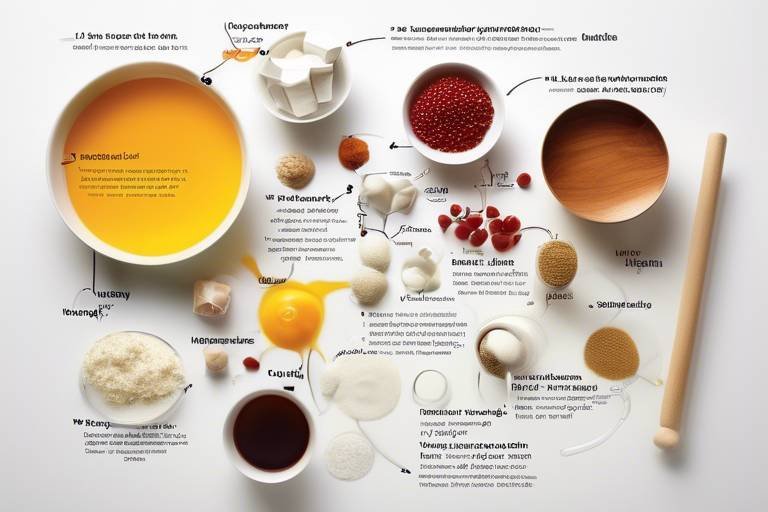How Air Quality Affects Your Health
Have you ever taken a deep breath and wondered what exactly you're inhaling? It's a question that many of us overlook in our daily lives, yet the answer is crucial for our well-being. The air we breathe is not just a mixture of gases; it's a cocktail of pollutants that can significantly impact our health. With increasing industrialization and urbanization, the quality of the air around us is deteriorating, and this decline poses serious health risks. From respiratory issues to cardiovascular diseases, the effects of poor air quality are profound and far-reaching.
Imagine walking through a bustling city, surrounded by honking cars and towering buildings, only to realize that the air you’re breathing is laden with harmful particles. This scenario is not just a figment of imagination; it's a reality for millions of people around the globe. Poor air quality can lead to a myriad of health problems, including asthma, lung cancer, and heart disease. In fact, the World Health Organization estimates that air pollution is responsible for approximately 7 million premature deaths each year. These statistics are alarming, and they highlight the urgent need for awareness and action.
So, what exactly makes air quality so important? Clean air is essential for maintaining not just individual health, but also public health and environmental sustainability. When we breathe in clean air, our bodies function optimally, and our immune systems are better equipped to fight off illnesses. On the other hand, contaminated air can lead to chronic health conditions that affect our quality of life. Communities that prioritize clean air often experience lower healthcare costs, increased productivity, and a higher overall quality of life.
Understanding the various components of air quality is vital. Common air pollutants, such as particulate matter, nitrogen dioxide, and ozone, each have unique sources and health implications. For instance, particulate matter, often found in smoke and vehicle emissions, can penetrate deep into our lungs, causing serious respiratory issues. Nitrogen dioxide, primarily produced from vehicle exhaust, is another significant contributor to poor air quality, leading to inflammation of the airways and other health complications.
As we delve deeper into the subject, it becomes evident that certain populations are more vulnerable to the adverse effects of poor air quality. Children, the elderly, and individuals with pre-existing health conditions are particularly at risk. For example, children's developing lungs are more susceptible to the harmful effects of air pollution, which can hinder their growth and lead to lifelong health issues. This vulnerability underscores the importance of targeted interventions and community efforts to improve air quality.
In conclusion, the air we breathe plays a pivotal role in our health and well-being. By understanding the impact of air quality on our bodies and advocating for cleaner air, we can take significant steps towards a healthier future. It's not just about individual health; it's about creating a sustainable environment for generations to come. So, the next time you step outside, take a moment to appreciate the air you breathe and consider how you can contribute to cleaner air for all.
- What are the main sources of air pollution? Common sources include vehicle emissions, industrial discharges, and household products.
- How can I improve indoor air quality? Use air purifiers, ensure proper ventilation, and avoid smoking indoors.
- Are there specific groups more affected by air pollution? Yes, children, the elderly, and those with pre-existing health conditions are particularly vulnerable.
- What can communities do to improve air quality? Communities can advocate for cleaner transportation options, enforce regulations on emissions, and promote green spaces.

The Importance of Air Quality
Understanding air quality is crucial as it directly influences public health, environmental sustainability, and overall quality of life. Imagine stepping outside your home and taking a deep breath of fresh air; it feels invigorating, right? Now, consider the opposite scenario where the air is thick with pollution. That simple act of breathing can become a health hazard. Clean air is not just a luxury; it is a fundamental necessity for a thriving community.
Air quality affects everyone, but its impact is particularly pronounced in densely populated urban areas, where industrial activities and traffic congestion can lead to elevated levels of pollutants. Poor air quality can exacerbate existing health conditions, leading to increased hospital visits and healthcare costs. In fact, the World Health Organization estimates that around 7 million people die prematurely each year due to air pollution-related diseases. This staggering statistic underscores the need for immediate action to improve air quality.
Moreover, the importance of air quality extends beyond human health. It plays a vital role in maintaining ecosystems and biodiversity. Pollutants can damage crops, forests, and bodies of water, leading to a cascade of negative effects on wildlife and plant life. When air quality deteriorates, it can disrupt the delicate balance of nature, affecting everything from the food we eat to the water we drink. Thus, maintaining clean air is essential for both human and environmental health.
To illustrate the various ways air quality impacts our lives, let's break it down into a few key areas:
- Health Risks: Poor air quality can lead to respiratory diseases, cardiovascular problems, and even neurological issues.
- Economic Costs: Increased healthcare costs and lost productivity due to illness can strain local economies.
- Environmental Impact: Pollutants can harm wildlife, damage forests, and contribute to climate change.
In summary, air quality is not just an environmental issue; it is a public health crisis that demands our attention. By understanding its importance, we can advocate for cleaner air initiatives and policies that promote a healthier future for ourselves and generations to come.

Common Air Pollutants
When we talk about air quality, it’s crucial to understand that not all air is created equal. There are various pollutants lurking in the atmosphere, each with its own unique sources and health implications. These pollutants can significantly impact our well-being, leading to a range of health issues. Let’s delve into some of the most common air pollutants and the risks they pose.
One of the most concerning types of air pollution is particulate matter (PM). This is a mixture of tiny particles and droplets in the air that can penetrate deep into our lungs. PM can originate from numerous sources, including vehicle emissions, industrial processes, and even natural events like wildfires. The health effects of particulate matter exposure can be severe, especially for vulnerable populations such as children and the elderly.
Particulate matter is categorized based on size: PM10 (particles with diameters of 10 micrometers and smaller) and PM2.5 (2.5 micrometers and smaller). The smaller the particle, the deeper it can penetrate into the respiratory system, causing more harm. Health effects associated with PM exposure include respiratory diseases, cardiovascular issues, and even premature death. It’s like having a tiny intruder in your lungs, wreaking havoc on your health.
The short-term effects of PM exposure may include irritation of the eyes, nose, and throat, along with coughing and difficulty breathing. Long-term exposure can lead to serious health conditions such as chronic bronchitis, heart disease, and lung cancer. The impact of PM is particularly pronounced in sensitive groups, including children, the elderly, and those with pre-existing health conditions. It’s alarming to think that something as invisible as air can have such tangible effects on our health.
So, how can we protect ourselves from the dangers of particulate matter? Here are some practical tips:
- Improve indoor air quality: Use air purifiers and ensure proper ventilation in your home.
- Monitor air quality: Stay informed about local air quality reports and avoid outdoor activities during high pollution days.
- Advocate for cleaner air policies: Support initiatives aimed at reducing emissions from vehicles and industries.
Another significant pollutant to consider is nitrogen dioxide (NO2). This gas is primarily produced from vehicle emissions and industrial processes, and it can have serious health implications. Exposure to nitrogen dioxide can lead to respiratory problems and can exacerbate conditions like asthma. Reducing NO2 levels is crucial, especially in urban areas where traffic congestion is a major issue. It’s like a double whammy: not only are we dealing with the emissions from our vehicles, but we’re also putting our health at risk.
In summary, understanding common air pollutants and their health implications is vital for our well-being. By being aware of these pollutants and taking steps to reduce exposure, we can protect ourselves and our communities. Clean air isn’t just a luxury; it’s a necessity for a healthy life.
Q: What are the main sources of particulate matter?
A: Particulate matter can come from various sources, including vehicle emissions, industrial processes, construction activities, and natural events like wildfires.
Q: How can I check the air quality in my area?
A: You can check local air quality by visiting websites like AirNow or using apps that provide real-time air quality updates based on your location.
Q: Who is most at risk from air pollutants?
A: Vulnerable populations include children, the elderly, pregnant women, and individuals with pre-existing health conditions like asthma or heart disease.
Q: What steps can communities take to improve air quality?
A: Communities can advocate for cleaner transportation options, increase green spaces, and support policies aimed at reducing emissions from industries.

Particulate Matter
Particulate matter (PM) is a term that refers to tiny particles suspended in the air, and it's one of the most concerning air pollutants. These minute particles can be as small as 2.5 micrometers in diameter, which is about 30 times smaller than a human hair. This size allows them to penetrate deep into the lungs and even enter the bloodstream, posing serious health risks. The sources of particulate matter are varied and can include vehicle emissions, industrial discharges, construction activities, and even natural occurrences like wildfires and volcanic eruptions.
When we breathe in these particles, they can wreak havoc on our bodies. The health effects of PM are not just limited to the lungs; they can also affect the heart and brain. Long-term exposure to high levels of particulate matter has been linked to chronic respiratory diseases, cardiovascular problems, and even premature death. Vulnerable populations, such as children, the elderly, and individuals with pre-existing health conditions, are particularly at risk. They may experience more severe health impacts, which can lead to increased hospital visits and healthcare costs.
To better understand the implications of particulate matter on health, consider the following table that summarizes the health effects associated with different sizes of particulate matter:
| Particle Size | Health Effects |
|---|---|
| PM2.5 | Can penetrate the lungs and enter the bloodstream, leading to heart attacks, strokes, and respiratory diseases. |
| PM10 | Can cause respiratory issues, such as asthma and chronic bronchitis, particularly in vulnerable populations. |
Reducing exposure to particulate matter is crucial for maintaining good health. Here are some effective strategies:
- Improve Indoor Air Quality: Use air purifiers, keep windows closed on high pollution days, and ensure proper ventilation.
- Advocate for Cleaner Air Policies: Support local initiatives aimed at reducing emissions from vehicles and industries.
- Limit Outdoor Activities: On days when air quality is poor, try to stay indoors, especially during peak traffic hours.
In conclusion, understanding the sources and impacts of particulate matter is essential for protecting our health and well-being. By taking proactive steps to reduce exposure, we can help safeguard ourselves and our communities from the harmful effects of air pollution.
- What is particulate matter? Particulate matter refers to tiny particles in the air that can be harmful to health when inhaled.
- How does particulate matter affect health? Exposure to particulate matter can lead to respiratory diseases, cardiovascular issues, and other serious health problems.
- Who is most at risk from particulate matter? Vulnerable populations, including children, the elderly, and those with pre-existing health conditions, are at higher risk.
- What can I do to reduce my exposure to particulate matter? Improve indoor air quality, advocate for cleaner air policies, and limit outdoor activities on polluted days.

Health Effects of PM
Particulate matter (PM) is not just an abstract term tossed around in environmental discussions; it’s a real threat that can significantly affect your health. These tiny particles, often invisible to the naked eye, can infiltrate your lungs and even enter your bloodstream, leading to a myriad of health issues. Imagine inhaling a cloud of dust that contains harmful substances—this is what exposure to PM is like. The health effects can vary widely depending on the size of the particles, their chemical composition, and the length of exposure.
Short-term exposure to particulate matter can trigger immediate health problems such as:
- Respiratory Issues: Symptoms like coughing, throat irritation, and shortness of breath can occur.
- Cardiovascular Strain: PM exposure can lead to increased heart rates and blood pressure, putting stress on your heart.
- Worsening of Asthma: For those with asthma, PM can exacerbate symptoms, leading to more frequent attacks.
But the dangers don’t stop there. Long-term exposure to particulate matter can have even graver consequences. Studies have shown that it is linked to chronic respiratory diseases, cardiovascular diseases, and even lung cancer. The World Health Organization (WHO) has categorized PM as a carcinogen, underscoring its serious health implications. Think of it as a slow poison; while you might not feel the effects immediately, over time, the damage accumulates, leading to severe health outcomes.
Particularly vulnerable populations, such as children, the elderly, and individuals with pre-existing health conditions, are at an even greater risk. For children, exposure to PM can hinder lung development and lead to lifelong respiratory issues. The elderly, on the other hand, may find their existing health problems exacerbated by poor air quality. It’s crucial to recognize that while PM affects everyone, some groups bear a heavier burden.
To illustrate the health effects of PM, consider the following table that summarizes key health risks associated with different particle sizes:
| Particle Size | Health Risks |
|---|---|
| PM10 (10 micrometers and smaller) | Respiratory issues, asthma attacks, lung infections |
| PM2.5 (2.5 micrometers and smaller) | Cardiovascular diseases, lung cancer, premature death |
| Ultrafine Particles (<0.1 micrometers) | Neurological effects, systemic inflammation, heart disease |
In summary, the health effects of particulate matter are profound and far-reaching. It’s not just about the air we breathe; it’s about the quality of our lives. Awareness and action are essential. By understanding the risks associated with PM exposure, we can take steps to protect ourselves and advocate for cleaner air policies that benefit everyone.
Q1: What are particulate matter and its sources?
A1: Particulate matter (PM) is a mixture of tiny particles and droplets in the air that can be inhaled. Common sources include vehicle emissions, industrial discharges, and natural occurrences like wildfires.
Q2: How can I reduce my exposure to PM?
A2: You can reduce exposure by staying indoors on high pollution days, using air purifiers, and advocating for policies that promote cleaner air.
Q3: Are there specific health risks for children due to PM?
A3: Yes, children are particularly vulnerable as exposure to PM can affect their lung development and lead to long-term respiratory issues.

Reducing PM Exposure
Reducing exposure to particulate matter (PM) is not just a personal responsibility; it’s a community effort that can lead to healthier living environments for everyone. Imagine walking into a home where the air feels fresh and clean—this is not just a dream, but an achievable reality. The first step in minimizing PM exposure starts with understanding the sources of these pollutants and taking proactive measures to combat them. Indoor air quality plays a crucial role in our overall health, as many people spend a significant amount of time indoors.
One effective way to enhance indoor air quality is by using air purifiers. These devices can filter out harmful particles, making the air you breathe cleaner. When selecting an air purifier, look for models that include HEPA filters, as they are specifically designed to capture tiny particles. Additionally, regularly cleaning your home can significantly reduce dust and other particulate matter. Vacuuming with a HEPA-filter vacuum and dusting surfaces can prevent the accumulation of harmful pollutants.
Moreover, it's essential to ensure proper ventilation in your home. Opening windows when outdoor air quality is good can help circulate fresh air inside. However, be cautious during high pollution days; check local air quality reports to avoid bringing in more pollutants. You can also consider using exhaust fans in kitchens and bathrooms to remove excess moisture and pollutants from cooking and bathing activities.
On a broader scale, advocating for cleaner air policies is vital. Engaging with local government and community organizations can help push for regulations that limit emissions from vehicles and industries. Participating in community clean-up events and tree-planting initiatives not only beautifies your surroundings but also contributes to better air quality. Trees act as natural air filters, absorbing pollutants and providing oxygen in return.
Lastly, consider adopting lifestyle changes that can collectively make a difference. Using public transportation, carpooling, or biking instead of driving can significantly reduce vehicle emissions, a major source of PM. By making conscious choices about your transportation and energy consumption, you contribute to a larger movement towards cleaner air.
In summary, reducing PM exposure requires a multifaceted approach that includes improving indoor air quality, advocating for cleaner air policies, and making environmentally conscious choices. Remember, every small step counts in the journey toward a healthier environment for you and your community.
- What are the main sources of particulate matter? Particulate matter can originate from various sources, including vehicle emissions, industrial processes, construction activities, and even natural sources like wildfires.
- How can I check the air quality in my area? You can check local air quality by visiting websites like AirNow or using apps that provide real-time air quality updates based on your location.
- Are there specific plants that can help improve indoor air quality? Yes, certain houseplants like spider plants, peace lilies, and snake plants are known for their air-purifying qualities.
- What should I do on days when air quality is poor? On days of poor air quality, limit outdoor activities, keep windows closed, and use air purifiers to maintain indoor air quality.

Nitrogen Dioxide
Nitrogen dioxide (NO2) is a harmful gas that primarily emerges from the combustion of fossil fuels, particularly from vehicle emissions and industrial processes. It's important to understand that while we often think of air pollution as something we can see, NO2 is a colorless gas that can silently infiltrate our environments, making it even more insidious. This pollutant not only contributes to the formation of smog but also plays a significant role in the development of respiratory issues. Imagine trying to breathe in a crowded, smoky room; that’s the kind of impact NO2 can have on your lungs, especially for those who are already vulnerable.
One of the most concerning aspects of nitrogen dioxide is its ability to exacerbate existing health conditions. For instance, individuals suffering from asthma may find their symptoms worsening in environments with high NO2 levels. But it’s not just those with pre-existing conditions who are affected. Even healthy individuals can experience irritation of the airways, decreased lung function, and increased susceptibility to respiratory infections. The implications are far-reaching, affecting not just personal health but also overall community well-being.
To give you a clearer picture, let’s look at some sources of nitrogen dioxide:
- Vehicle emissions, especially from diesel engines
- Power plants that burn fossil fuels
- Industrial facilities
- Residential heating systems
Understanding where NO2 comes from is crucial for implementing effective measures to combat its effects. In urban areas, where traffic congestion is a daily reality, NO2 levels can soar, particularly during rush hour. This makes it vital for city planners and policymakers to prioritize cleaner air initiatives. By investing in public transportation, encouraging the use of electric vehicles, and promoting the use of renewable energy sources, we can significantly reduce nitrogen dioxide emissions.
Moreover, monitoring air quality is essential. Communities can benefit from real-time data on nitrogen dioxide levels, allowing residents to make informed decisions about outdoor activities. For instance, if NO2 levels are high, it might be wise to limit outdoor exercise or choose to stay indoors, especially for those at higher risk.
In conclusion, while nitrogen dioxide may not be visible to the naked eye, its effects are profoundly felt. By raising awareness about its sources and health implications, we can take actionable steps towards cleaner air. Reducing nitrogen dioxide levels is not just a personal health issue; it's a community challenge that requires collective effort and commitment.
What are the main sources of nitrogen dioxide?
Nitrogen dioxide primarily comes from vehicle emissions, industrial processes, and the burning of fossil fuels for heating and electricity.
How does nitrogen dioxide affect health?
Exposure to nitrogen dioxide can lead to respiratory issues, aggravate asthma, and decrease lung function, particularly in vulnerable populations.
What can I do to reduce my exposure to nitrogen dioxide?
You can reduce your exposure by staying indoors during high pollution days, using air purifiers, and advocating for cleaner transportation options in your community.
Are there any regulations on nitrogen dioxide emissions?
Yes, many countries have established air quality standards and regulations to limit nitrogen dioxide emissions from vehicles and industrial sources.

Vulnerable Populations
When we talk about air quality, it’s not just a matter of numbers and statistics; it’s about real people, especially those who are more vulnerable to the adverse effects of pollution. Certain groups, such as children, the elderly, and individuals with pre-existing health conditions, face heightened risks from poor air quality. Imagine a child playing outside, breathing in the same air as an adult, yet their developing lungs are far more susceptible to damage. It’s a stark reminder that air quality impacts everyone, but not equally.
Children, for instance, are at a critical stage in their development. Their bodies are still growing, and their respiratory systems are not fully developed, making them particularly sensitive to pollutants. Studies have shown that exposure to air pollution can lead to long-term health issues, including asthma and other respiratory ailments. The effects can be devastating, affecting their ability to learn and thrive in their formative years. The World Health Organization reports that around 93% of children under the age of 15 live in environments where air pollution levels exceed guidelines, which is a staggering statistic that should concern us all.
On the other end of the spectrum, the elderly are also vulnerable. As we age, our bodies naturally become less resilient. Chronic health conditions such as heart disease and lung disorders can be exacerbated by poor air quality. For older adults, even short-term exposure to pollutants can trigger serious health complications. It’s as if their bodies are already fighting a battle, and air pollution is an unwelcome enemy that makes things worse.
Moreover, individuals with pre-existing health issues, such as asthma or cardiovascular diseases, are in a precarious position. For them, air quality is not just a matter of comfort; it’s a matter of survival. Pollutants can act as triggers, leading to severe health crises that could have been avoided. Therefore, it’s essential to recognize these populations and advocate for better air quality measures.
To illustrate the impact of air quality on different vulnerable groups, consider the following table:
| Population Group | Health Risks | Protective Measures |
|---|---|---|
| Children | Asthma, developmental issues | Limit outdoor activities during high pollution days |
| Elderly | Respiratory diseases, cardiovascular issues | Regular health check-ups, stay indoors when pollution is high |
| Individuals with Pre-existing Conditions | Worsening of existing health problems | Use air purifiers, follow medical advice |
It’s clear that addressing air quality is not just an environmental concern; it’s a public health priority. By focusing on the needs of vulnerable populations, we can implement targeted interventions that not only protect these groups but also improve overall community health. It’s time to take action and advocate for cleaner air, not just for ourselves, but for those who need it the most.
- What are the main pollutants that affect vulnerable populations? Common pollutants include particulate matter (PM), nitrogen dioxide (NO2), and ozone, which can exacerbate health issues in sensitive groups.
- How can I protect my family from air pollution? Staying indoors during high pollution days, using air purifiers, and advocating for cleaner air policies are effective ways to protect your family.
- Are there specific areas more affected by air pollution? Yes, urban areas with heavy traffic and industrial activity tend to have higher pollution levels, impacting nearby vulnerable populations.

Children's Health Risks
When it comes to air quality, children are often the most vulnerable. Their bodies are still developing, which makes them particularly susceptible to the harmful effects of air pollution. Just imagine a sponge soaking up water; that's how children absorb pollutants, affecting their health in profound ways. Studies show that exposure to poor air quality can lead to a myriad of health issues that can last a lifetime.
One of the most concerning aspects is how air pollution can impact respiratory health. Children breathe faster than adults, which means they inhale more air—and consequently, more pollutants—per pound of body weight. This increased exposure can lead to serious conditions such as asthma, bronchitis, and other chronic respiratory diseases. In fact, according to the World Health Organization, approximately 500 million children live in areas where air pollution exceeds recommended levels. This statistic serves as a wake-up call for parents and policymakers alike.
Moreover, the effects of air pollution extend beyond immediate respiratory issues. Research indicates that prolonged exposure can hinder lung development, leading to reduced lung function in adulthood. Children exposed to high levels of pollutants may find themselves struggling with conditions that could have been prevented with cleaner air. It's like trying to build a house on a shaky foundation; without a solid start, the structure is bound to face problems later on.
But it’s not just respiratory issues that we need to worry about. Air quality can also influence neurological development. Emerging studies suggest a link between air pollution and cognitive impairments in children, including difficulties with attention and learning. This is particularly alarming as it can affect their academic performance and overall quality of life. The brain is like a garden; if you don't provide the right conditions, it won't flourish as it should.
To combat these risks, it’s essential for parents to take proactive measures. Here are some practical steps to help protect children from the dangers of air pollution:
- Monitor Air Quality: Use apps or websites that provide real-time air quality updates.
- Limit Outdoor Activities: On days when pollution levels are high, keep children indoors as much as possible.
- Create a Clean Indoor Environment: Use air purifiers and ensure proper ventilation in your home.
- Advocate for Change: Support local initiatives aimed at reducing emissions and improving air quality.
In summary, the risks that poor air quality poses to children's health are both significant and alarming. As caregivers, it’s our responsibility to safeguard our children’s future by advocating for cleaner air and taking actionable steps to minimize their exposure to pollutants. After all, a healthy child is the foundation of a thriving community.
Q1: How can I check the air quality in my area?
A1: You can check local air quality by visiting websites like AirNow or using mobile apps that provide real-time updates based on your location.
Q2: What are the symptoms of poor air quality in children?
A2: Common symptoms include coughing, wheezing, shortness of breath, and increased frequency of asthma attacks.
Q3: Are there any long-term effects of air pollution on children's health?
A3: Yes, long-term exposure can lead to chronic respiratory diseases, reduced lung function, and potential cognitive impairments.
Q4: What steps can schools take to improve air quality?
A4: Schools can improve air quality by ensuring proper ventilation, using air purifiers, and conducting regular maintenance on heating and cooling systems.
Q5: How can I advocate for better air quality policies?
A5: You can advocate by joining local environmental groups, attending town hall meetings, and contacting your representatives to express your concerns about air quality.

Strategies for Improvement
Improving air quality is not just a lofty goal; it’s a necessity for our health and well-being. So, how can we tackle this pressing issue? The answer lies in a combination of individual actions, community efforts, and robust policy changes. Each of us has a role to play, and together, we can create a cleaner, healthier environment.
First and foremost, individual awareness is key. By understanding how our daily activities impact air quality, we can make conscious decisions that contribute to cleaner air. For instance, consider your mode of transportation. Opting for public transport, biking, or walking not only reduces emissions but also promotes a healthier lifestyle. Did you know that switching to energy-efficient appliances at home can significantly reduce indoor air pollutants? It's true! These small changes can create a ripple effect, inspiring others to follow suit.
On a community level, organizing clean-up drives and tree-planting events can drastically improve local air quality. Trees act as natural air filters, absorbing carbon dioxide and releasing oxygen. Imagine a neighborhood bustling with greenery; it’s not just beautiful, but it’s also a breath of fresh air—literally! Furthermore, advocating for local policies that prioritize air quality can lead to sustainable changes. Engaging with local government officials and participating in town hall meetings are great ways to voice concerns and push for cleaner air initiatives.
To give you a clearer picture, here’s a table highlighting effective strategies for improving air quality:
| Strategy | Description | Impact |
|---|---|---|
| Energy Efficiency | Use energy-efficient appliances and light bulbs. | Reduces indoor air pollutants and energy consumption. |
| Public Transportation | Encourage the use of buses, trains, and carpools. | Decreases vehicle emissions and traffic congestion. |
| Tree Planting | Organize community tree-planting events. | Improves air quality and enhances local biodiversity. |
| Advocacy | Engage with local government on air quality policies. | Promotes regulations that protect public health. |
Finally, public awareness campaigns can be incredibly effective in spreading the word about air quality issues. Social media, workshops, and local events can educate the community about the importance of clean air and motivate individuals to take action. Remember, knowledge is power! The more people understand the connection between air quality and health, the more likely they are to change their habits and support initiatives aimed at improving our air.
In conclusion, improving air quality is a multifaceted challenge that requires collective effort. By making informed choices, engaging with our communities, and advocating for effective policies, we can all contribute to a healthier environment. Every action counts, and together, we can breathe easier.
Q: What are the main sources of air pollution?
A: Major sources include vehicle emissions, industrial processes, and household products that release volatile organic compounds (VOCs).
Q: How can I check the air quality in my area?
A: You can use online resources like the Air Quality Index (AQI) websites or apps that provide real-time data on air quality levels.
Q: Are there specific times when air quality is worse?
A: Yes, air quality can worsen during peak traffic hours, in the early morning, or on hot, sunny days when ground-level ozone can form.
Q: What can I do indoors to improve air quality?
A: Use air purifiers, keep windows open for ventilation, avoid smoking indoors, and regularly clean your home to reduce dust and allergens.
Frequently Asked Questions
- What is air quality and why is it important?
Air quality refers to the cleanliness of the air we breathe, influenced by pollutants like particulate matter and gases. It's crucial because poor air quality can lead to serious health issues, affecting everyone, especially vulnerable groups like children and the elderly.
- What are the common air pollutants?
Common air pollutants include particulate matter (PM), nitrogen dioxide (NO2), and ozone. Each of these pollutants comes from different sources, such as vehicle emissions and industrial activities, and can have various harmful effects on health.
- How does particulate matter affect health?
Particulate matter can penetrate deep into the lungs and even enter the bloodstream, leading to respiratory and cardiovascular diseases. Long-term exposure can exacerbate existing health conditions and increase the risk of serious illnesses.
- Who is most at risk from air pollution?
Vulnerable populations, including children, the elderly, and individuals with pre-existing health conditions, are at higher risk from air pollution. Their bodies may react more severely to pollutants, leading to long-term health issues.
- What steps can I take to reduce my exposure to air pollution?
You can reduce your exposure by staying indoors on high pollution days, using air purifiers, and advocating for cleaner air policies in your community. Simple actions like avoiding heavy traffic areas can also make a difference.
- How can communities improve air quality?
Communities can improve air quality by implementing green spaces, promoting public transportation, and encouraging the use of renewable energy sources. Public awareness campaigns can also play a significant role in educating residents about air quality issues.
- What role does government policy play in air quality?
Government policy is vital in regulating emissions from industries and vehicles, setting air quality standards, and promoting public health initiatives. Strong policies can lead to significant improvements in air quality and overall public health.
- How can I monitor air quality in my area?
You can monitor air quality using various apps and websites that provide real-time data on pollution levels. Many local environmental agencies also publish air quality reports that can help you stay informed.



















